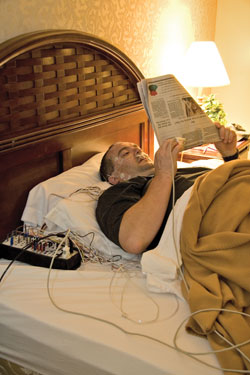
At a SleepMed diagnosis and therapy center in
Maryland, a participant has his sleep patterns and
possible problems diagnosed.
Photo: lepoldphotography.com
Depending on your symptoms, it may help you to gather information on your sleep behaviors. Your healthcare provider will review this information and consider several possible tests when trying to diagnose a sleep disorder:
Sleep history and sleep log. If you believe you have a sleep problem, consider keeping a sleep diary and bringing it to your next medical appointment. Your physician will ask you how many hours you sleep each night, how often you awaken during the night and for how long, how long it takes you to fall asleep, how well rested you feel upon awakening, and how sleepy you feel during the day. If you don't already keep a sleep diary, your health professional may ask you to keep one for a few weeks. (See sample sleep diary on page 21.) Your provider also may ask you whether you have any symptoms of a sleep disorder, such as loud snoring, snorting or gasping, morning headaches, tingling or unpleasant sensations in the limbs that are relieved by moving them, and jerking of the limbs during sleep. You may want to ask your sleeping partner if you have these symptoms, since you may not be aware of them yourself.
Sleep recording in a sleep laboratory (polysomnogram). A sleep recording or polysomnogram (PSG) is usually done while you stay overnight at a sleep center or sleep laboratory. Electrodes and other monitors are placed on your scalp, face, chest, limbs, and finger. While you sleep, these devices measure your brain activity, eye movements, muscle activity, heart rate and rhythm, blood pressure, and how much air moves in and out of your lungs. This test also checks the amount of oxygen in your blood. A PSG test is painless. In certain circumstances, the PSG can be done at home. A home monitor can be used to record heart rate, how air moves in and out of your lungs, the amount of oxygen in your blood, and your breathing effort.
Multiple sleep latency test (MSLT). This daytime sleep study measures how sleepy you are and is particularly useful for diagnosing narcolepsy. The MSLT is conducted in a sleep laboratory and typically done after an overnight sleep recording (PSG). In this test, monitoring devices for sleep stage are placed on your scalp and face. You are asked to nap four or five times for 20 minutes every two hours during the day. Technicians note how quickly you fall asleep and how long it takes you to reach various stages of sleep, especially REM (rapid eye movement) sleep, during your naps. Normal individuals either do not fall asleep during these short designated naptimes or take a long time to fall asleep. People who fall asleep in less than five minutes are likely to require treatment for a sleep disorder, as are those who quickly reach REM sleep during their naps.
What are Sleep Studies?
Sleep studies are tests that measure how well you sleep and how your body responds to sleep problems. These tests can help your healthcare provider find out whether you have a sleep disorder and how severe it is. Sleep studies are important because untreated sleep disorders can raise your risk for heart disease, high blood pressure, stroke, and other medical conditions. Sleep disorders also have been linked to an increased risk of injury, such as falling (in the elderly) and car accidents.
Research is helping to improve our understanding of the connection between sleep disorders and the impact of untreated sleep disorders on our physical, mental, and behavioral health. NIH supports a range of sleep-related research that focuses on:
- Better understanding of how a lack of sleep increases the risk for obesity, diabetes, heart disease, and stroke.
- Genetic, environmental, and social factors that lead to sleep disorders.
- The adverse effects from a lack of sleep on body and brain.
